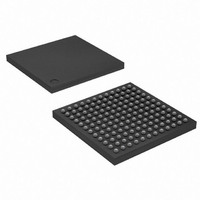AT91SAM7L128-CU Atmel, AT91SAM7L128-CU Datasheet - Page 388

AT91SAM7L128-CU
Manufacturer Part Number
AT91SAM7L128-CU
Description
MCU ARM7 128K HS FLASH 144-LFBGA
Manufacturer
Atmel
Series
AT91SAMr
Datasheet
1.AT91SAM7L64-CU.pdf
(564 pages)
Specifications of AT91SAM7L128-CU
Core Processor
ARM7
Core Size
16/32-Bit
Speed
36MHz
Connectivity
I²C, SPI, UART/USART
Peripherals
Brown-out Detect/Reset, LCD, POR, PWM, WDT
Number Of I /o
80
Program Memory Size
128KB (128K x 8)
Program Memory Type
FLASH
Ram Size
6K x 8
Voltage - Supply (vcc/vdd)
1.55 V ~ 1.8 V
Data Converters
A/D 4x10b
Oscillator Type
Internal
Operating Temperature
-40°C ~ 85°C
Package / Case
144-LFBGA
Processor Series
AT91SAMx
Core
ARM7TDMI
Data Bus Width
32 bit
Data Ram Size
6 KB
Interface Type
2-Wire, SPI, USART
Maximum Clock Frequency
36 MHz
Number Of Programmable I/os
80
Number Of Timers
3
Maximum Operating Temperature
+ 85 C
Mounting Style
SMD/SMT
3rd Party Development Tools
JTRACE-ARM-2M, MDK-ARM, RL-ARM, ULINK2
Development Tools By Supplier
AT91SAM-ICE, AT91-ISP, AT91SAM7L-EK
Minimum Operating Temperature
- 40 C
On-chip Adc
10 bit, 4 Channel
For Use With
AT91SAM7L-STK - KIT EVAL FOR AT91SAM7LAT91SAM-ICE - EMULATOR FOR AT91 ARM7/ARM9
Lead Free Status / RoHS Status
Lead free / RoHS Compliant
Eeprom Size
-
Lead Free Status / Rohs Status
Details
Available stocks
Company
Part Number
Manufacturer
Quantity
Price
Company:
Part Number:
AT91SAM7L128-CU
Manufacturer:
Atmel
Quantity:
2 660
- Current page: 388 of 564
- Download datasheet (9Mb)
30.6.4
30.6.4.1
30.6.4.2
388
AT91SAM7L128/64 Preliminary
ISO7816 Mode
ISO7816 Mode Overview
Protocol T = 0
The USART features an ISO7816-compatible operating mode. This mode permits interfacing
with smart cards and Security Access Modules (SAM) communicating through an ISO7816 link.
Both T = 0 and T = 1 protocols defined by the ISO7816 specification are supported.
Setting the USART in ISO7816 mode is performed by writing the USART_MODE field in the
Mode Register (US_MR) to the value 0x4 for protocol T = 0 and to the value 0x5 for protocol T =
1.
The ISO7816 is a half duplex communication on only one bidirectional line. The baud rate is
determined by a division of the clock provided to the remote device (see
on page
The USART connects to a smart card as shown in
tional and the Baud Rate Generator feeds the ISO7816 clock on the SCK pin. As the TXD pin
becomes bidirectional, its output remains driven by the output of the transmitter but only when
the transmitter is active while its input is directed to the input of the receiver. The USART is con-
sidered as the master of the communication as it generates the clock.
Figure 30-30. Connection of a Smart Card to the USART
When operating in ISO7816, either in T = 0 or T = 1 modes, the character format is fixed. The
configuration is 8 data bits, even parity and 1 or 2 stop bits, regardless of the values pro-
grammed in the CHRL, MODE9, PAR and CHMODE fields. MSBF can be used to transmit LSB
or MSB first. Parity Bit (PAR) can be used to transmit in normal or inverse mode. Refer to
“USART Mode Register” on page 400
The USART cannot operate concurrently in both receiver and transmitter modes as the commu-
nication is unidirectional at a time. It has to be configured according to the required mode by
enabling or disabling either the receiver or the transmitter as desired. Enabling both the receiver
and the transmitter at the same time in ISO7816 mode may lead to unpredictable results.
The ISO7816 specification defines an inverse transmission format. Data bits of the character
must be transmitted on the I/O line at their negative value. The USART does not support this for-
mat and the user has to perform an exclusive OR on the data before writing it in the Transmit
Holding Register (US_THR) or after reading it in the Receive Holding Register (US_RHR).
In T = 0 protocol, a character is made up of one start bit, eight data bits, one parity bit and one
guard time, which lasts two bit times. The transmitter shifts out the bits and does not drive the
I/O line during the guard time.
If no parity error is detected, the I/O line remains at 1 during the guard time and the transmitter
can continue with the transmission of the next character, as shown in
367).
USART
SCK
TXD
and
“PAR: Parity Type” on page
Figure
CLK
I/O
30-30. The TXD line becomes bidirec-
Smart
Card
Figure
401.
“Baud Rate Generator”
6257A–ATARM–20-Feb-08
30-31.
Related parts for AT91SAM7L128-CU
Image
Part Number
Description
Manufacturer
Datasheet
Request
R

Part Number:
Description:
KIT EVAL FOR AT91SAM7L
Manufacturer:
Atmel
Datasheet:

Part Number:
Description:
DEV KIT FOR AVR/AVR32
Manufacturer:
Atmel
Datasheet:

Part Number:
Description:
INTERVAL AND WIPE/WASH WIPER CONTROL IC WITH DELAY
Manufacturer:
ATMEL Corporation
Datasheet:

Part Number:
Description:
Low-Voltage Voice-Switched IC for Hands-Free Operation
Manufacturer:
ATMEL Corporation
Datasheet:

Part Number:
Description:
MONOLITHIC INTEGRATED FEATUREPHONE CIRCUIT
Manufacturer:
ATMEL Corporation
Datasheet:

Part Number:
Description:
AM-FM Receiver IC U4255BM-M
Manufacturer:
ATMEL Corporation
Datasheet:

Part Number:
Description:
Monolithic Integrated Feature Phone Circuit
Manufacturer:
ATMEL Corporation
Datasheet:

Part Number:
Description:
Multistandard Video-IF and Quasi Parallel Sound Processing
Manufacturer:
ATMEL Corporation
Datasheet:

Part Number:
Description:
High-performance EE PLD
Manufacturer:
ATMEL Corporation
Datasheet:

Part Number:
Description:
8-bit Flash Microcontroller
Manufacturer:
ATMEL Corporation
Datasheet:

Part Number:
Description:
2-Wire Serial EEPROM
Manufacturer:
ATMEL Corporation
Datasheet:











